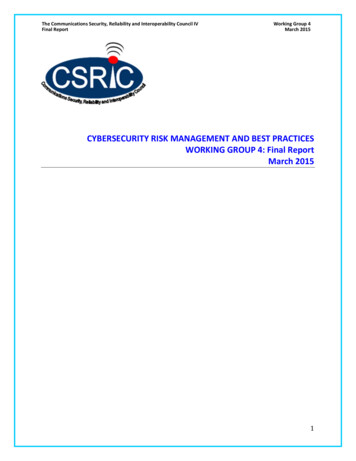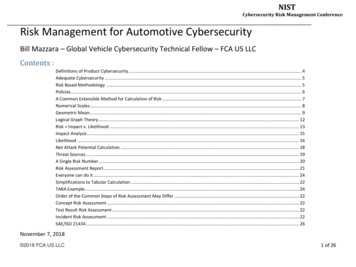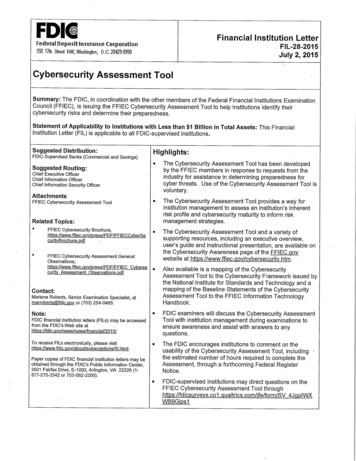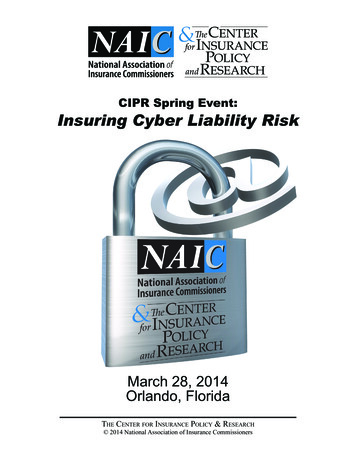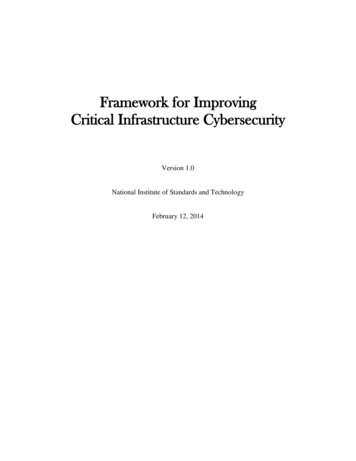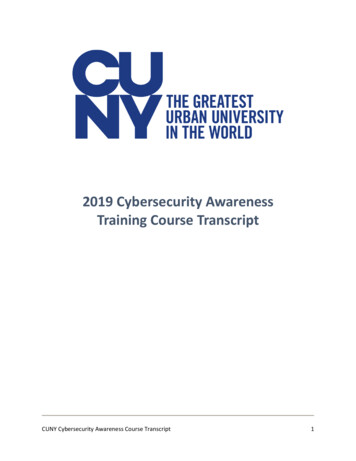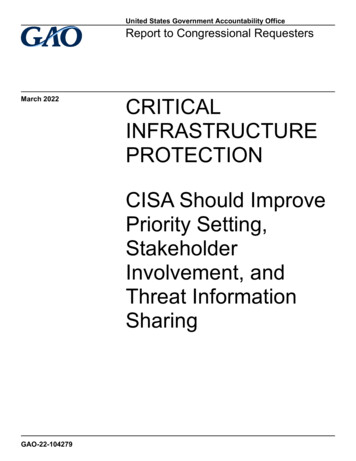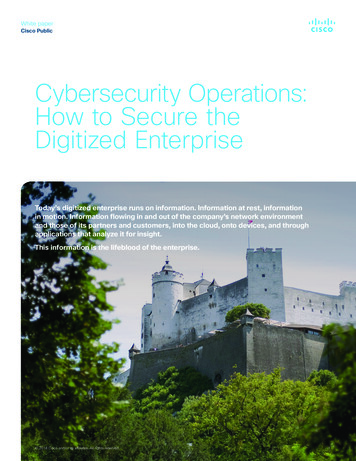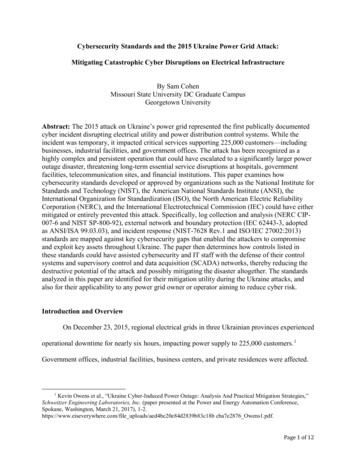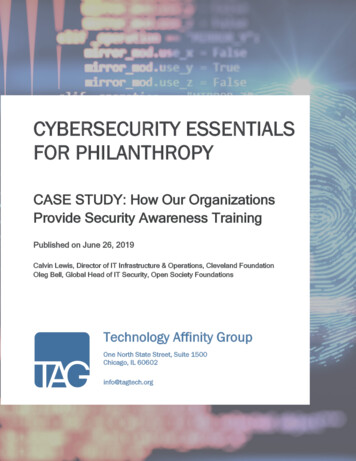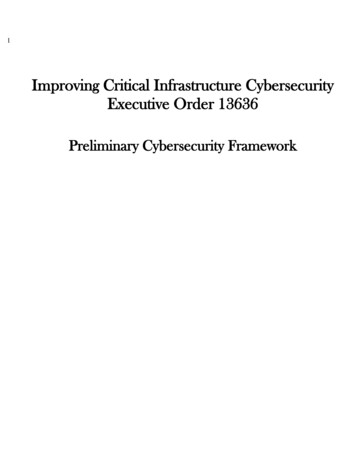
Transcription
1Improving Critical Infrastructure CybersecurityExecutive Order 13636Preliminary Cybersecurity Framework
Preliminary Cybersecurity Framework2Note to Reviewers345The Preliminary Cybersecurity Framework for improving critical infrastructure cybersecurity isnow available for review. The Preliminary Cybersecurity Framework is provided by the NationalInstitute of Standards and Technology (NIST).6789If the Cybersecurity Framework is to be effective in helping to reduce cybersecurity risk to theNation’s critical infrastructure, it must be able to assist organizations in addressing a variety ofcybersecurity challenges. The National Institute of Standards and Technology (NIST) requeststhat reviewers consider the following 3031Does the Preliminary Framework: adequately define outcomes that strengthen cybersecurity and support businessobjectives? enable cost-effective implementation? appropriately integrate cybersecurity risk into business risk? provide the tools for senior executives and boards of directors to understand risks andmitigations at the appropriate level of detail? provide sufficient guidance and resources to aid businesses of all sizes while maintainingflexibility? provide the right level of specificity and guidance for mitigating the impact ofcybersecurity measures on privacy and civil liberties? express existing practices in a manner that allows for effective use?32Disclaimer333435Any mention of commercial products is for information only; it does not imply NISTrecommendation or endorsement, nor does it imply that the products mentioned are necessarilythe best available for the purpose.Will the Preliminary Framework, as presented: be inclusive of, and not disruptive to, effective cybersecurity practices in use today,including widely-used voluntary consensus standards that are not yet final? enable organizations to incorporate threat information?Is the Preliminary Framework: presented at the right level of specificity? sufficiently clear on how the privacy and civil liberties methodology is integrated withthe Framework Core?i
Preliminary Cybersecurity Framework36Table of Contents371.0Framework Introduction .1382.0Framework Basics .5393.0How to Use the Framework .1140Appendix A: Framework Core.1341Appendix B: Methodology to Protect Privacy and Civil Liberties for a Cybersecurity Program .2842Appendix C: Areas for Improvement for the Cybersecurity Framework .3643Appendix D: Framework Development Methodology .4044Appendix E: Glossary .4245Appendix F: Acronyms .44464748List of Figures49Figure 1: Framework Core Structure . 550Figure 2: Profile Comparisons . 851Figure 3: Notional Information and Decision Flows within an Organization . 95253545556List of Tables57Table 1: Framework Core . 1358Table 2: Function and Category Unique Identifiers . 2759Table 3: Methodology to Protect Privacy and Civil Liberties for a Cybersecurity Program . 28606162ii
Preliminary Cybersecurity Framework631.064656667686970The national and economic security of the United States depends on the reliable functioning ofcritical infrastructure. To strengthen the resilience of this infrastructure, President Obama issuedExecutive Order 13636 (EO), “Improving Critical Infrastructure Cybersecurity” on February 12,2013.1 This Executive Order calls for the development of a voluntary Cybersecurity Framework(“Framework”) that provides a “prioritized, flexible, repeatable, performance-based, and costeffective approach” for assisting organizations responsible for critical infrastructure services tomanage cybersecurity risk.717273747576Critical infrastructure is defined in the EO as “systems and assets, whether physical or virtual, sovital to the United States that the incapacity or destruction of such systems and assets would havea debilitating impact on security, national economic security, national public health or safety, orany combination of those matters.” Due to the increasing pressures from external threats,organizations responsible for critical infrastructure need to have a consistent and iterativeapproach to identifying, assessing, and managing cybersecurity risk.77787980818283The critical infrastructure community includes public and private owners and operators, andother supporting entities that play a role in securing the Nation’s infrastructure. Each sectorperforms critical functions that are supported by information technology (IT), industrial controlsystems (ICS) and, in many cases, both IT and ICS.2 To manage cybersecurity risks, a clearunderstanding of the security challenges and considerations specific to IT and ICS is required.Because each organization’s risk is unique, along with its use of IT and ICS, the implementationof the Framework will vary.84858687The Framework, developed in collaboration with industry, provides guidance to an organizationon managing cybersecurity risk. A key objective of the Framework is to encourage organizationsto consider cybersecurity risk as a priority similar to financial, safety, and operational risk whilefactoring in larger systemic risks inherent to critical infrastructure.88899091929394The Framework relies on existing standards, guidance, and best practices to achieve outcomesthat can assist organizations in managing their cybersecurity risk. By relying on those practicesdeveloped, managed, and updated by industry, the Framework will evolve with technologicaladvances and business requirements. The use of standards will enable economies of scale todrive innovation and development of effective products and services that meet identified marketneeds. Market competition also promotes faster diffusion of these technologies and realization ofmany benefits by the stakeholders in these sectors.9596979899Building off those standards, guidelines, and practices, the Framework provides a commonlanguage and mechanism for organizations to: 1) describe their current cybersecurity posture; 2)describe their target state for cybersecurity; 3) identify and prioritize opportunities forimprovement within the context of risk management; 4) assess progress toward the target state;5) foster communications among internal and external stakeholders.12Framework Introduction78 FR 11737The DHS CIKR program provides a listing of the sectors and their associated critical functions and value chains.http://www.dhs.gov/critical-infrastructure1
Preliminary Cybersecurity Framework100101102103104The Framework complements, and does not replace, an organization’s existing business orcybersecurity risk management process and cybersecurity program. Rather, the organization canuse its current processes and leverage the Framework to identify opportunities to improve anorganization’s management of cybersecurity risk. Alternatively, an organization without anexisting cybersecurity program can use the Framework as a reference to establish one.105106107108109The goal of the open process in developing the Preliminary Framework was to develop a robusttechnical basis to allow organizations to align this guidance with their organizational practices.This Preliminary Framework is being issued for public comment for stakeholders to inform thenext version of the Framework that will be completed in February 2014, as required in 123124125126127128129130The Framework is a risk-based approach composed of three parts: the Framework Core, theFramework Profile, and the Framework Implementation Tiers. These components are detailedbelow. The Framework Core is a set of cybersecurity activities and references that are commonacross critical infrastructure sectors organized around particular outcomes. The Corepresents standards and best practices in a manner that allows for communication ofcybersecurity risk across the organization from the senior executive level to theimplementation/operations level. The Framework Core consists of five Functions—Identify, Protect, Detect, Respond, Recover—which can provide a high-level, strategicview of an organization’s management of cybersecurity risk. The Framework Core thenidentifies underlying key Categories and Subcategories for each of these Functions, andmatches them with example Informative References such as existing standards,guidelines, and practices for each Subcategory. This structure ties the high level strategicview, outcomes and standards based actions together for a cross-organization view ofcybersecurity activities. For instance, for the “Protect” Function, categories include: DataSecurity; Access Control; Awareness and Training; and Protective Technology. ISO/IEC27001 Control A.10.8.3 is an informative reference which supports the “Data duringtransportation/transmission is protected to achieve confidentiality, integrity, andavailability goals” Subcategory of the “Data Security” Category in the ppendix B contains a methodology to protect privacy and civil liberties for acybersecurity program as required under the Executive Order. Organizations may alreadyhave processes for addressing privacy risks such as a process for conducting privacyimpact assessments. The privacy methodology is designed to complement such processesby highlighting privacy considerations and risks that organizations should be aware ofwhen using cybersecurity measures or controls. As organizations review and selectrelevant categories from the Framework Core, they should review the correspondingcategory section in the privacy methodology. These considerations provide organizationswith flexibility in determining how to manage privacy risk.140141142Overview of the Framework A Framework Profile (“Profile”) represents the outcomes that a particular system ororganization has achieved or is expected to achieve as specified in the FrameworkCategories and Subcategories. The Profile can be characterized as the alignment of2
Preliminary Cybersecurity Framework143144145146147148149industry standards and best practices to the Framework Core in a particularimplementation scenario. Profiles are also used to identify opportunities for improvingcybersecurity by comparing a “Current” Profile with a “Target” Profile. The Profile canthen be used to support prioritization and measurement of progress toward the TargetProfile, while factoring in other business needs including cost-effectiveness andinnovation. In this sense, Profiles can be used to conduct self-assessments andcommunicate within an organization or between organizations. 150151152153154155156157158Framework Implementation Tiers (“Tiers”) describe how cybersecurity risk is managedby an organization. The Tier selection process considers an organization’s current riskmanagement practices, threat environment, legal and regulatory requirements,business/mission objectives, and organizational constraints. Tiers describe the degree towhich an organization’s cybersecurity risk management practices exhibit thecharacteristics (e.g., risk and threat aware, repeatable, and adaptive) defined in Section2.3. The Tiers characterize an organization’s practices over a range, from Partial (Tier 1)to Adaptive (Tier 4), progressing from informal, reactive implementations to approachesthat are agile and risk-informed.1591.2Risk Manageme nt and the Cybersecurity Framework160161162163Risk management is the process of identifying, assessing, and responding to risk. Particularlywithin critical infrastructure, organizations should understand the likelihood that a risk event willoccur and the resulting impact. With this information, organizations determine the acceptablelevel of risk for IT and ICS assets and systems, expressed as their risk tolerance.164165166167168With an understanding of risk tolerance, organizations can prioritize systems that requireattention. This will enable organizations to optimize cybersecurity expenditures. Furthermore,the implementation of risk management programs offers organizations the ability to quantify andcommunicate changes to organizational cybersecurity. Risk is also a common language that canbe communicated to internal and external stakeholders.169170171172173While not a risk management process itself, the Framework uses risk management processes toenable organizations to inform and prioritize decisions regarding cybersecurity. The Frameworkutilizes risk assessment to help organizations select optimized target states for cybersecurityactivities. Thus, the Framework gives organizations the ability to dynamically select and directimprovements in both IT and ICS cybersecurity risk management.174175176177178179A comprehensive risk management approach provides the ability to identify, assess, respond to,and monitor cybersecurity-related risks and provide organizations with the information to makeongoing risk-based decisions. Examples of cybersecurity risk management processes include theInternational Organization for Standardization (ISO) 31000, ISO 27005, NIST SpecialPublication (SP) 800-39 and the Electricity Sector Cybersecurity Risk Management Process(RMP) Guideline.180181182183Within the critical infrastructure, organizations vary widely in their business models, resources,risk tolerance, approaches to risk management, and effects on security, national economicsecurity, and national public health or safety. Because of these differences, the Framework isrisk-based to provide flexible implementation.3
Preliminary Cybersecurity Framework1841.3Docume nt Overview185The remainder of this document contains the following sections and appendices:186187 Section 2 describes the Framework components: the Framework Core, the Tiers, and theProfiles.188 Section 3 presents examples of how the Framework can be used.189190 Appendix A presents the Framework Core in a tabular format: the Functions, Categories,Subcategories, and Informative References.191192 Appendix B contains a methodology to protect privacy and civil liberties for acybersecurity program.193194 Appendix C discusses areas for improvement in cybersecurity standards and practicesidentified as a result of the Framework efforts to date.195 Appendix D describes the Framework development methodology.196 Appendix E contains a glossary of selected terms.197 Appendix F lists acronyms used in this document.1984
Preliminary Cybersecurity Framework1992.0200201202203204205The Framework provides a common language for expressing, understanding, and managingcybersecurity risk, both internally and externally. The Framework can be used to help identifyand prioritize actions for reducing cybersecurity risk and is a tool for aligning policy, business,and technological approaches to managing that risk. Different types of entities — includingsectors, organizations, and associations — can use the Framework for different means, includingthe creation of common Profiles.2062.1207208209210211212The Framework Core provides references to cybersecurity activities and Informative References.The Framework Core is not a checklist of activities to perform; it presents key cybersecurityoutcomes that are aligned with activities known to manage cybersecurity risk. These activitiesare mapped to a subset of commonly used standards and guidelines. The Framework Corecomprises four elements—Functions, Categories, Subcategories, and Informative References—depicted in Figure 1:213214Figure 1: Framework Core Structure215216217Framework BasicsFramework CoreThe Framework Core elements work together as follows: Functions organize basic cybersecurity activities at their highest level. These Functionsare: Identify, Protect, Detect, Respond, and Recover. The functions aid in communicating5
Preliminary Cybersecurity Frameworkthe state of an organization’s cybersecurity activities by organizing information, enablingrisk management decisions, addressing threats, and improving by learning from previousactivities. The functions also align with existing methodologies for incident management,and can be used to help show the impact of investments in cybersecurity. For example,investments in planning and exercises support timely response and recovery actions,resulting in reduced impact to delivery of services.218219220221222223224225226 Categories are the subdivisions of a Function into groups of cybersecurity outcomes,closely tied to programmatic needs and particular activities. Examples of Categoriesinclude “Asset Management,” “Access Control,” and “Detection Processes.”227228229230231 Subcategories further subdivide a Category into high-level outcomes, but are notintended to be a comprehensive set of practices to support a category. Examples ofsubcategories include “Physical devices and systems within the organization arecatalogued,” “Data-at-rest is protected,” and “Notifications from the detection system areinvestigated.”232233234235236237 Informative References are specific sections of standards, guidelines, and practicescommon among critical infrastructure sectors and illustrate a method to accomplish theactivities within each Subcategory. The Subcategories are derived from the InformativeReferences. The Informative References presented in the Framework Core are notexhaustive but are example sets, and organizations are free to implement other standards,guidelines, and practices.3238239240241See Appendix A for the complete Framework Core listing. In addition, Appendix B provides aninitial methodology to help organizations identify and mitigate impacts of the CybersecurityFramework and associated information security measures or controls on privacy and civilliberties.242The five Framework Core Functions defined below apply to both IT and ICS. 243244245246247248249250251Identify – Develop the institutional understanding to manage cybersecurity risk toorganizational systems, assets, data, and capabilities.The Identify Function includes the following categories of outcomes: Asset Management,Business Environment, Governance, Risk Assessment, and Risk ManagementStrategy. The activities in the Identify Function are foundational for effectiveimplementation of the Framework. Understanding the business context, resources thatsupport critical functions and the related cybersecurity risks enable an organization tofocus its efforts and resources. Defining a risk management strategy enables riskdecisions consistent with the business needs or the organization. 2522532543Protect – Develop and implement the appropriate safeguards, prioritized through theorganization’s risk management process, to ensure delivery of critical infrastructureservices.NIST developed a compendium of informative references gathered from the RFI input, CybersecurityFramework workshops, and stakeholder engagement during the Framework development process includesstandards, guidelines, and practices to assist with implementation. The Compendium is not intended to be anexhaustive list, but rather a starting point based on stakeholder input.6
Preliminary Cybersecurity Framework255256257258259260The Protect function includes the following categories of outcomes: Access Control,Awareness and Training, Data Security, Information Protection Processes andProcedures, and Protective Technology. The Protect activities are performed consistentwith the organization’s risk strategy defined in the Identify function. 261262263264265266267The Detect function includes the following categories of outcomes: Anomalies andEvents, Security Continuous Monitoring, and Detection Processes. The Detect functionenables timely response and the potential to limit or contain the impact of potential cyberincidents. 268269270271272273274275Detect – Develop and implement the appropriate activities to identify the occurrence of acybersecurity event.Respond – Develop and implement the appropriate activities, prioritized through theorganization’s risk management process (including effective planning), to take actionregarding a detected cybersecurity event.The Respond function includes the following categories of outcomes: Response Planning,Analysis, Mitigation, and Improvements. The Respond function is performed consistentwith the business context and risk strategy defined in the Identify function. The activitiesin the Respond function support the ability to contain the impact of a potentialcybersecurity event. 276277278279280Recover – Develop and implement the appropriate activities, prioritized through theorganization’s risk management process, to restore the capabilities or criticalinfrastructure services that were impaired through a cybersecurity event.The Recover function includes the following categories of outcomes: Recovery Planning,Improvements, and Communications. The activities performed in the Recover functionare performed consistent with the business context and risk strategy defined in theIdentify function. The activities in the Recover function support timely recovery tonormal operations to reduce the impact from a cybersecurity event.2812.2Framework Profile282283284285286287288289290291A Framework Profile (“Profile”) is a tool to enable organizations to establish a roadmap forreducing cybersecurity risk that is well aligned with organization and sector goals, considerslegal/regulatory requirements and industry best practices, and reflects risk managementpriorities. A Framework Profile can be used to describe both the current state and the desiredtarget state of specific cybersecurity activities, thus revealing gaps that should be addressed tomeet cybersecurity risk management objectives. Figure 2 shows the two types of Profiles:Current and Target. The Current Profile indicates the cybersecurity outcomes that are currentlybeing achieved. The Target Profile indicates the outcomes needed to achieve the desiredcybersecurity risk management goals. The Target Profile is built to support business/missionrequirements and aid in the communication of risk within and between organizations.292293294295296The Profile is the alignment of the Functions, Categories, Subcategories and industry standardsand best practices with the business requirements, risk tolerance, and resources of theorganization. Identifying the gaps between the Current Profile and the Target Profile allows thecreation of a prioritized roadmap that organizations will implement to reduce cybersecurity risk.The prioritization of the gaps is driven by the organization’s Risk Management Processes and7
Preliminary Cybersecurity Framework297298serve as an essential part for resource and time estimates needed that are critical to prioritizationdecisions.299300301Figure 2: Profile Comparisons302303304305306The Framework provides a mechanism for organizations, sectors, and other entities to createtheir own Target Profiles. It does not provide Target Profile templates; rather, sectors andorganizations should identify existing Target Profiles that could be customized for their purposesand needs.3072.3308309Figure 3 describes the notional flow of information and decisions within an organization: at thesenior executive level, at the business/process level, and at the implementation/operations level.310311312313314315316317The senior executive level communicates the mission priorities, available resources, and overallrisk tolerance to the business/process level. The business/process level uses the information asinputs into their risk management process, and then collaborates with theimplementation/operations level to create a Profile. The implementation/operation levelcommunicates the Profile implementation to the business/process level. The business/processlevel uses this information to perform an impact assessment. The outcomes of that impactassessment are reported to the senior executive level to inform the organization’s overall riskmanagement process.Coordi nation of F ramework Implementation8
Preliminary Cybersecurity Framework318319320Figure 3: Notional Information and Decision Flows within an e Framework Implementation Tiers (“Tiers”) describe how an organization manages itscybersecurity risk. The Tiers range from Partial (Tier 1) to Adaptive (Tier 4) and describe anincreasing degree of rigor and sophistication in cybersecurity risk management practices and theextent to which cybersecurity risk management is integrated into an organization’s overall riskmanagement practices. The Tier selection process considers an organization’s current riskmanagement practices, threat environment, legal and regulatory requirements, business/missionobjectives, and organizational constraints. Organizations should determine the desired Tier,ensuring that the selected levels meet the organizational goals, reduce cybersecurity risk tocritical infrastructure, and are feasible and cost-effective to implement. The Tier definitions areas follows:332 Framework Implementation TiersTier 1: Partial333334335336337o Risk Management Process – Organizational cybersecurity risk managementpractices are not formalized and risk is managed in an ad hoc and sometimesreactive manner. Prioritization of cybersecurity activities may not be directlyinformed by organizational risk objectives, the threat environment, orbusiness/mission requirements.338339340341o Integrated Program – There is a limited awareness of cybersecurity risk at theorganizational level and an organization-wide approach to managingcybersecurity risk has not been established. The organization implementscybersecurity risk management on an irregular, case-by-case basis due to varied9
Preliminary Cybersecurity Framework342343344experience or information gained from outside sources. The organization may nothave processes that enable cybersecurity information to be shared within theorganization.o External Participation – An organization may not have the processes in place toparticipate in coordination or collaboration with other entities.345346347 Tier 2: Risk-Informed348349o Risk Management Process – Risk management practices are approved bymanagement but may not be established as organizational-wide policy.350351352353354355o Integrated Program – There is an awareness of cybersecurity risk at theorganizational level but an organization-wide approach to managing cybersecurityrisk has not been established. Risk-informed, management-approved processesand procedures are defined and implemented and staff has adequate resources toperform their cybersecurity duties. Cybersecurity information is shared within theorganization on an informal basis.356357o External Participation – The organization knows its role in the larger ecosystem,but has not formalized its capabilities to interact and share information externally.358 Tier 3: Risk-Informed and Repeatable359360361362o Risk Management Process – The organization’s risk management practices areformally approved and expressed as policy. Organizational cybersecuritypractices are regularly updated based on the application of risk managementprocesses to a changing threat and technology landscape.363364365366367o Integrated Program – There is an organization-wide approach to managecybersecurity risk. Risk-informed policies, processes, and procedures are defined,implemented as intended, and validated. Consistent methods are in place toeffectively respond to changes in risk. Personnel possess the knowledge and skillsto perform their appointed roles and responsibilities.368369370o External Participation – The organization understands its dependencies andpartners and receives information from these partners enabling collaboration andrisk-based management decisions within the organization in response to events.371 Tier 4: Adaptive372373374375376o Risk Management Process – The organization adapts its cybersecurity practicesbased on lessons learned and predictive indicators derived from previouscybersecurity activities. Through a process of continuous improvement, theorganization actively adapts to a changing cybersecurity landscape and respondsto emerging/evolving threats in a timely manner.377378379380381382o Integrated Program – There is an organization-wide approach to managingcybersecurity risk that uses risk-informed policies, processes, and procedures toaddress potential cybersecurity events. Cybersecurity risk management is part ofthe organizational culture and evolves from an awareness of previous activities,information shared by other sources, and continuous awareness of activities ontheir systems and networks.10
Preliminary Cybersecurity Frameworko External Participation – The organization manages risk and actively sharesinformation with partners to ensure that accurate, current information is beingdistributed and consumed to improve cybersecurity before an event occurs.383384385386387388389Organizations should consider leveraging external guidance, such as informat
64 The national and economic security of the United States depends on the reliable functioning of 65 critical infrastructure. To strengthen the resilience of this infrastructure, President Obama issued 66 Executive Order 13636 (EO), "Improving Critical Infrastructure Cybersecurity" on February 12,
